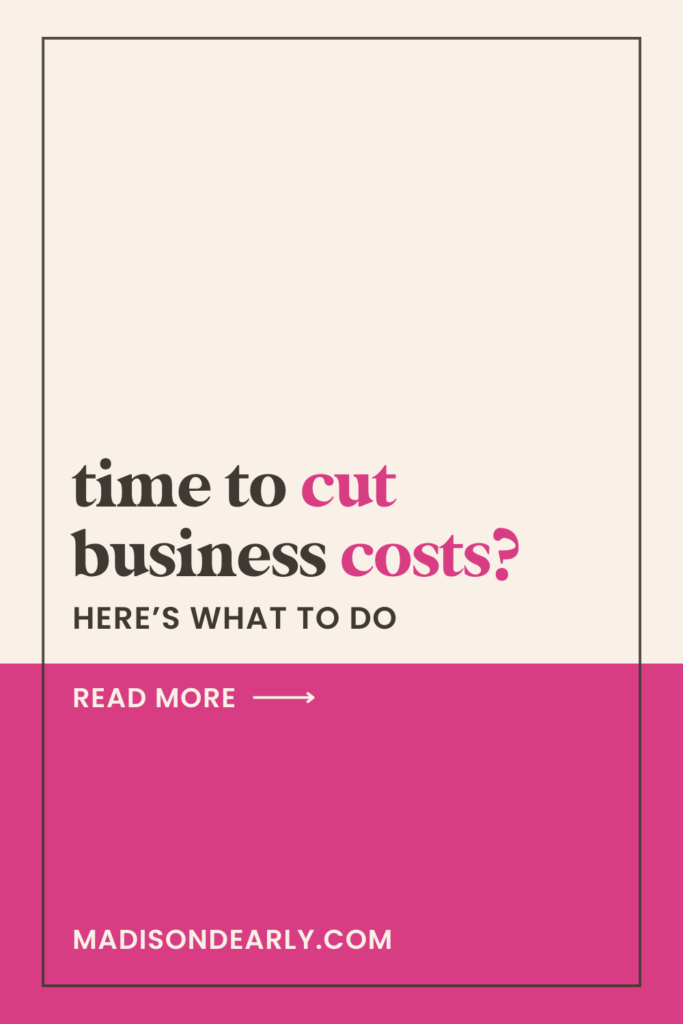Meet Madison Dearly
We offer top notch bookkeeping for brand and web designers who think big. Most importantly, we're here to make your numbers accessible and understandable. Curious about working with us? Come take a peek!
5 Ways Better Bookkeeping Can SAVE You Money
DOWNLOAD NOW
Time to Cut Business Costs? Here’s What to Do
May 23, 2023
Running a business costs money — it’s just a fact.
But all the money you spend on your business affects your profit. Remember, Profit = Revenue – Expenses. If you can trim those costs, you can keep more of your hard-earned income.
But how do you know which expenses you can cut safely? You don’t want to make changes that will affect how you serve your customers or impact your quality of life.
You’ve got to figure out which costs are essential and which are negotiable. And then, you’ve got to decide how you want to change those negotiable expenses.
Where do you start? Yep — with your books! When your books are complete and up to date, they’ll show you exactly where you can cut expenses.
I’m going to walk you through how to analyze and adjust your spending. I’ve got advice on evaluating your expenditures and tips for making changes that will have the biggest impact.
So grab your favorite beverage and your latest P&L, and let’s get started!
You can’t always cut business costs
Let’s face it — there are some expenses in your business that you just can’t eliminate. You’re not going to get out of paying your taxes. And there’s no realistic way to get out of paying credit card processing fees either.
I know it’s frustrating to see how much of your money is going to Stripe (or whichever payment processor you use). But the alternative is worse — how annoying would it be to try to collect cash or paper checks from your clients?
No one wants to do that.
And your customers want the convenience of being able to pay by credit card. So just try to shift your perspective a little and look at those processing fees as a “thank you” to your payment processor for dealing with all that stuff so you don’t have to. (And remember, those processing fees are tax-deductible business expenses!)
Finding negotiable expenses
While you can’t lower your taxes or your payment processing fees, there are probably some other expenses that you can reduce.
Start by categorizing your expenses into two categories:
- Costs that “directly” make you money
- Costs that buy back your time
Cost of Goods Sold
Let’s take a quick look at the COGS section of your P&L. All of the expenses in there are directly related to the goods and services that you sell to your customers. For example, if you contract out some of the work that your clients pay you for, the money you pay those contractors is a COGS expense.
As long as you’re working with people you trust, there’s nothing inherently wrong with hiring a contractor. And when you hire a contractor to help with some of the work that your clients pay you for, it can increase your profits by allowing you to expand your service offerings outside your particular expertise. And when you have others helping you with the work, you might be able to bring on more clients.
Operating expenses
Some of the expenses in your business aren’t directly related to your revenue — they’re more about “buying back” your time. For example, if you pay a VA to handle all your admin tasks, the money you’re spending is giving you back the time you’d otherwise spend doing those tasks yourself. These costs generally fall into the Operating (or Overhead) Expenses category of your P&L.
Even though these costs don’t directly affect your revenue, they might still be worth it. It’s all about how you use that time you’ve bought back.
If you hire a VA and get 15 hours of your week back and use all of that time to binge-watch your favorite show, your business probably isn’t getting a return on that investment.
But you could use those 15 hours on tasks that grow your business and generate more revenue:
- Creating new offers
- Networking
- Expanding your marketing
- Growing your professional skills via courses or professional development resources
The cost of buying back your time might be totally worth it. You’ve just got to be honest about how you’re using that time.
(Side note: Seasons of rest are crucial, and there may be occasions when it’s the right choice to buy back your time so you can rest more. The key is to be honest with yourself so you know when you truly need rest vs. when you’re just going through a period of low motivation.)
Analyze the return on your investments
When you’re deciding which expenses to cut, look for things you’re not using or investments that aren’t really getting you anything in return. For example, let’s say you join an online group for business owners, but you just never find the time to read the materials, watch the videos, or interact with the community.
You’re not getting a return on your investment — so that’s an expense that you’re better off cutting. And same goes for software subscriptions that you’re paying for and not using.
Evaluating your employees can be a little more challenging. It takes a lot more thought to decide whether it’s time to cut an employee. That decision affects a person’s livelihood, and you shouldn’t make it lightly. And honestly, I truly believe that if you hire the right person for your business, you will make more money. If that’s not happening, it might be worth taking another look at your hiring and management practices.
If you’re starting to question whether a team member is worth what you’re paying them, ask yourself whether you’re giving them the support and opportunities to contribute in a meaningful way. And if you still decide it’s time to part ways, make sure you treat that employee with kindness and respect.
The easiest way to evaluate your costs
Want help figuring out which of your business expenses are worthwhile? I’ve got something for you — my ROI Tracker Tool!
This tool shows you exactly where you are with all your KPIs (key performance indicators). That means you can look at your stats, like revenue, leads, and contacts, and compare the current numbers to your goals.
Treating expenses as investments

It’s crucial to have a plan — yes, a full plan! — for any investment you make in your business. Don’t commit to new expenses (especially something long-term like an annual subscription or a new team member) without having a clear goal for what you want that money to do.
And then, keep watching those numbers over time. You should be able to see which of your expenses are helping you make progress toward your goals — and which aren’t. You’ll know exactly where to make cuts!
Boost profits by cutting unnecessary expenses
There are lots of places in your business where you need to spend money. Those expenses are generally either COGS or overhead costs. And some of them are never going away. But there might be others that you can trim down or cut entirely.
It’s all about taking an honest look at what you’re getting in return for the money you’re spending. If there are expenses that just aren’t helping you meet your goals, it’s probably best to drop them.
How can you analyze your expenses? Start by going through your P&L and looking for costs that you can’t easily link to a benefit. You can also use this ROI Tracker Tool to easily see which of your expenses are contributing to your business’s success.
Remember, before you can analyze your expenses, you need to get your books up to date. And if that’s just not something you have the time or desire to do yourself, my team and I would love to help!
We’ll track and record all of your transactions so your books are always up to date. Plus, we’ll provide you with
- Monthly reports with crucial data about your revenue, expenses, and profits — all the info that really matters!
- Quarterly Loom videos made just for you to show you exactly how to analyze your numbers and get more out of your reports.
- A full library of digital resources.
- Visual reports with graphs and charts that are easy — and fun — to read!
- Access to me and my team via Voxer, so you can ask questions and get the support you need.
Interested in that kind of support for YOUR creative online business?

Leave a Reply Cancel reply
Join The Monthly Book(keeping) Club
If you’re doing your bookkeeping yourself... AND PUTTING IT OFF for months at a time
JOIN THE CLUB
A done-with-you monthly bookkeeping membership for the online business owner who wants to learn how to do their business bookkeeping and actually get it done each month.
SITE CREDIT
Terms and Conditions
Privacy Policy
Want my best business finance tips delivered straight to your inbox? Join my email list here!
SUBSCRIBE
Madison Dearly Financial is the only comprehensive accounting firm exclusively serving creative small businesses.
Bookkeeping & Tax Services for CREATIVE PROFESSIONALS
PHOTOGRAPHY
Madison Dearly Financial is an independent firm and is not affiliated with, endorsed by, or officially associated with any accounting software platforms such as Xero, QuickBooks, or Gusto. All trademarks belong to their respective owners.
Pricing Note: Listed prices reflect base rates. Final pricing may vary based on the scope, complexity, and timeline of the project. Payment plans may be available upon approval.
Timeline Note: Estimated timelines are based on receiving timely client responses and smooth implementation. Projects with custom needs or delays may require additional time.
Content Disclaimer: Our blog content is for educational purposes only and does not replace professional financial, legal, or tax advice. We aim to keep information current and helpful—please consult a licensed expert before making decisions based on this content.
Home
About
Work With Us
Template Shop
Membership
Blog
Resources
Contact
Go ahead—
check us out!
We're an open book.
[…] you’re running an online business, an auditor might look twice at your returns if you have excessive food and travel costs. So what does “excessive” mean? There’s not really a dollar-value threshold — it’s more […]
[…] So figure out what that magic number is for you. And start tracking your hours to see if the time spent on projects is worth the payout. […]